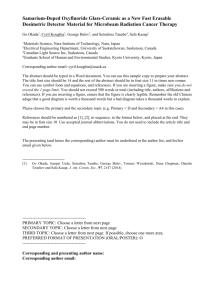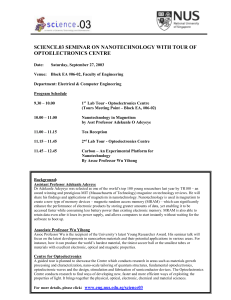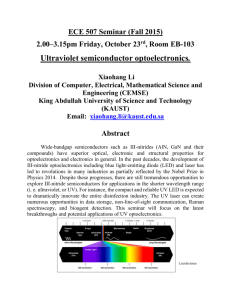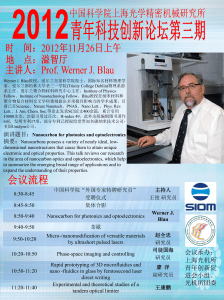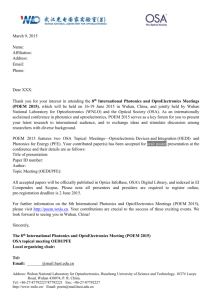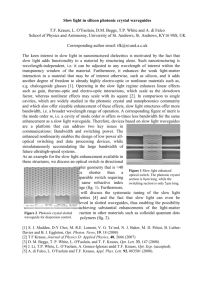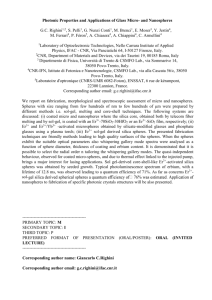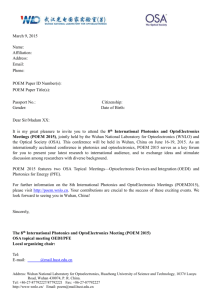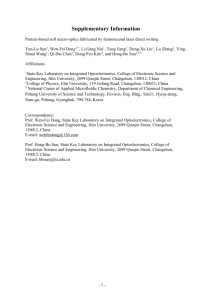Biography of a Killer Technology
advertisement
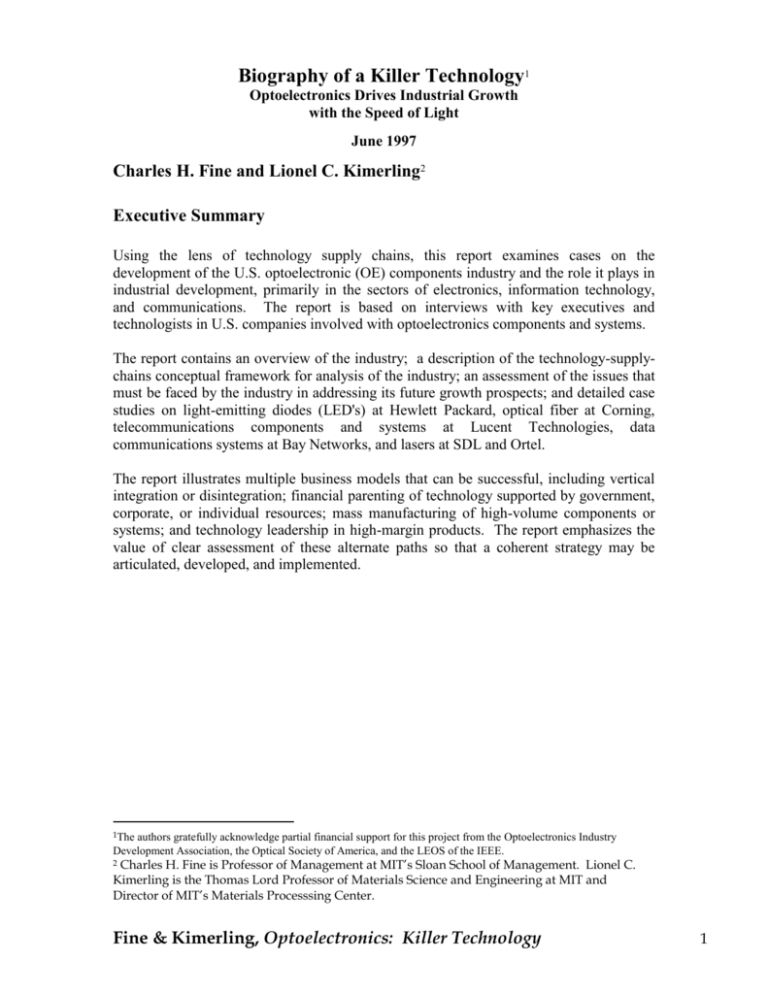
Biography of a Killer Technology1 Optoelectronics Drives Industrial Growth with the Speed of Light June 1997 Charles H. Fine and Lionel C. Kimerling2 Executive Summary Using the lens of technology supply chains, this report examines cases on the development of the U.S. optoelectronic (OE) components industry and the role it plays in industrial development, primarily in the sectors of electronics, information technology, and communications. The report is based on interviews with key executives and technologists in U.S. companies involved with optoelectronics components and systems. The report contains an overview of the industry; a description of the technology-supplychains conceptual framework for analysis of the industry; an assessment of the issues that must be faced by the industry in addressing its future growth prospects; and detailed case studies on light-emitting diodes (LED's) at Hewlett Packard, optical fiber at Corning, telecommunications components and systems at Lucent Technologies, data communications systems at Bay Networks, and lasers at SDL and Ortel. The report illustrates multiple business models that can be successful, including vertical integration or disintegration; financial parenting of technology supported by government, corporate, or individual resources; mass manufacturing of high-volume components or systems; and technology leadership in high-margin products. The report emphasizes the value of clear assessment of these alternate paths so that a coherent strategy may be articulated, developed, and implemented. 1The authors gratefully acknowledge partial financial support for this project from the Optoelectronics Industry Development Association, the Optical Society of America, and the LEOS of the IEEE. Charles H. Fine is Professor of Management at MIT’s Sloan School of Management. Lionel C. Kimerling is the Thomas Lord Professor of Materials Science and Engineering at MIT and Director of MIT’s Materials Processsing Center. 2 Fine & Kimerling, Optoelectronics: Killer Technology 1 The Speed of Light Technology yardsticks are a traditional measure of the advance of civilization as it tames nature to increase the standard of living. The ages of materials have marched from stone to steel to silicon, while systems have evolved from manual control to mechanical control to electronic control. Each technology has grown to support a dominant economic emphasis of farming, then machinery, and today information. As we pass the peak of the acceleration curve for the silicon age, many are compelled to ask what comes next. . . . Light travels at the physical limit of velocity for any known entity. The use of light in communications has been popularly recognized since the days of smoke signals. This early communications system transformed mechanical energy from the sender into modulated light signals that could be detected by line-of-sight observation. Light was used, because it traveled faster and with less attenuation than an acoustic (voice) signal. The amount of information was limited, not by the speed of propagation, but by the rate of modulation of the rising smoke intensity. Today, tiny lasers, the size of a grain of sand, convert electrical signals to high-speed photonic pulses that carry data, voice, and video information along fiber optic waveguides at the speed of light. This explosion of the information age has propelled optoelectronics, i.e., lightwave telecommunications, into the role of the next killer technology. Optoelectronics refers to the transduction of signals between light and electricity. The optoelectronics industry, which is quite fragmented, consists of numerous systems houses and component suppliers. On the component side: Lucent and Corning produce optical fiber; a variety of companies produce laser sources including Lucent for telecommunications, Sony for compact disk players and SDL for optical amplifier pumps; LEDs (light emitting diodes) for displays are produced by Hewlett Packard and Sharp; CCDs (charged coupled devices) for imaging are produced by Matsushita; and LCDs (liquid crystal displays) for portable systems are produced by Sharp and others. On the systems side, Lucent, Cisco, 3COM, and Bay Networks are all major network providers; Sony leads in tape and related optical storage media; Hewlett Packard and Lucent produce optical transceivers; Kodak and Canon lead in imaging; and Sharp leads in displays. Optoelectronics has revolutionized smoke-signal communications by high rate electronic modulation of light using tiny semiconductor lasers and by confining and guiding light down ultra low-loss glass fibers called optical waveguides. The signal from the laser and the optical fiber is detected by a photodiode device that is identical in function to the solar cell, but specific in design to the wavelength (color) and modulation rate of the laser light source. This point-to-point, optical communications system can simultaneously carry more than one million traditional copper wire telephone calls. It also provides the "asphalt" for the modern super-highway we now call the internet. We define a "killer technology" as one that delivers enhanced systems performance of a factor of at least a hundred-fold per decade. In the semiconductor industry, the well- Fine & Kimerling, Optoelectronics: Killer Technology 2 known Moore's law3 named after Gordon Moore, co-founder and chairman of Intel, quantifies the exponential growth of semiconductor capability--the killer technology of the 1980's and 1990's. Performance of integrated circuits shows dramatic growth in transistors per chip, cost per transistor and data processing speed during that period. Relative Information Capacity (bi t/s) Figure 1 plots the information carrying capacity of telecommunications systems since their inception in the late 1800s. For almost a century, this technology crept along at a growth rate of approximately 10/decade due to incrementally improving electromechanical, electronic and microwave technology. Note the change in slope to the ‘killer’ rate which occurs after the arrival of lightwave systems in the late 1970s. 10 14 10 12 10 10 10 Multi-channel (WDM) OPTICAL FIBER SYSTEMS Single channel (ETDM) 8 Communication Satellites 10 6 Advanced coaxial and microwave systems 10 4 10 2 10 Early coaxial cable links Carrier Telephony first used 12 voice channels on one wire pair 0 Telephone lines first constructed 10 -2 1880 1900 1920 1940 1960 1980 2000 2020 2040 Year Figure 1. Capacity of Major Telecommunications Highways. Note that the pace of capacity increase follows a less than “killer pace” until the advent of optical fiber systems in the mid-1980s. Technology Supply Chains Killer component technologies are important. However, for the vast majority of industrial goods and services, economic value is delivered to final consumers via long supply chains comprising many individual organizations, technologies, services, and capabilities. Therefore, to explore thoroughly the structure and dynamic forces in industries, one must understand both the component technologies and the system of industrial chains that link together the individual components. Consider the technology supply chains anchored by optoelectronics components. Increasingly, these optoelectronics components provide the foundation for an enormous amount of economic activity as a result of their placement as core technological Moore's law states that semiconductor performance/price will double every eighteen months, yielding 210/1.5 or about 100-fold per decade 3 Fine & Kimerling, Optoelectronics: Killer Technology 3 components in the rapidly growing computer, electronics, and communications industries. However, to understand the present and future role of these technologies, one must analyze the entire chain. The pervasive deployment of optoelectronic systems in data networking and high capacity telecommunications is key to the cost reduction and added functionality that propel growth in these sectors. The OE components industry had worldwide sales of $15.6B in 1995 with an annual growth rate of 20%. This components industry is dwarfed by the sectors it enables in the data/communications sector of semiconductors at $150B, telecommunications at $250B, electronics at $750B and U.S. information at $993B. Economic Impact of Optoelectronics, 1995 (adapted from OIDA, 7-10-96) Global Economy $27 Trillion Information $993 Billion Electronics $735 Billion Telecom $250 Billion OE components $15.6 Billion As illustrated in Figure 2, the OIDA estimates that the $15.6B component supplier sector of the OE industry directly support on the order of 50 times that volume in services and products. This data/communications industry structure gives great leverage to the optoelectronic sector in determining the ‘technology multiplier’ that governs growth. Fine & Kimerling, Optoelectronics: Killer Technology 4 Industrial (and/or governmental) organizations that control killer technologies often perceive a heady sense of power tinged with a monumental sense of responsibility for the economic fortunes of a large and critical portion of their economy's industrial competitiveness. Consider the case of semiconductors. Following the 1970's in which the world's developed economies were made painfully aware of their dependence on fossil fuels, the next decade opened with semiconductors being touted as the "crude oil of the 1980's." American semiconductor manufacturers and their equipment suppliers dominated every aspect of the industry thought to be the key to future prosperity. By mid-decade, however, due in part to extremely aggressive investment in Japan, U.S. market share in chips and chipmaking technology was plummeting even as the industry grew rapidly. Alarmed and chastened, the industry banded together to launch with the U.S. government an organization named Sematech, whose charter was to reverse the frightening trends in the industry. With the help of Sematech, the U.S. semiconductor industry has had a very productive decade. Notably, one of Sematech's primary functions has evolved to the design and coordination of the industry's technology supply chains. Sematech supports the development of a manufacturing infrastructure and industry technology roadmaps which help reduce the risk to companies of investing in new technology. This coordinated evolution of a consensus view plays a critical role in maintaining the pace of technology development in a highly capital intensive industry. Supply chain issues often play a pivotal role in the fortunes of component suppliers--even for killer technologies. This report highlights the role of these chains in the issues facing the optoelectronics industry. In particular, the choices to be made towards vertical integration or disintegration, the supply of capital for technology development, the development of effective supply chains to support key technologies, and the control of downstream markets to support high volume production are all addressed. Supply Chain Design: Learning from the "Fruit Flies" In analyzing the supply chain issues for the industry, we have relied on a framework and examples developed by Fine (1996, 1998) which suggest examining fast-clockspeed or "fruit fly" industries to observe dynamic supply chain phenomena in rapidly-evolving industries as benchmarks for other industry situations. Geneticists study the rapidlyevolving fruit fly species in order to observe numerous data points in short periods of time to develop dynamic models of biological system evolution which are then tested for slowly evolving species such as humans. Similarly, we reference observations of dynamic processes in "fast clockspeed" industries to develop hypotheses about possible future changes in the optoelectronics (OE) industry. One of the fruit fly industries that we have found to be particularly revealing is the personal computer (PC) industry. In the early 1980's, IBM, which represented a significant majority of the worldwide computer industry had a technology supply chain decision to make as it entered the nascent PC industry. That is, IBM needed to concurrently design a product, a process, and a supply chain for that product. The technology supply chain they chose featured a relatively modular product architecture Fine & Kimerling, Optoelectronics: Killer Technology 5 combined with systems. reliance on Intel for microprocessors and Microsoft for operating Fifteen years and six product generations later (8086, 286, 386, 486, Pentium, PentiumPro) one can observe some fairly dramatic impacts of IBM's technology supply chain decision. IBM is still a large company by the standards of the computer industry, but, from the standpoint of their customers, one of the most critical features of their personal computer products is the logo on the machine denoting Intel Inside--a perhaps humiliating comedown from industry domination in the 1980s. Because of the widespread adoption of Intel and Microsoft technical standards, stimulated by IBM's decision to design these standards into their technology supply chain, relative power and leverage shifted along the supply chain--away from IBM onto its suppliers. IBM's choices about where to draw organizational boundaries for the extended organization and the supply chain resulted in the capture of less of the economic rents and industry power/leverage than they had presumably sought. The lesson from this fruit fly: when designing your supply chain, beware of the possible model of Intel Inside. This framework is explored further, through case examples, in the appendix to this document. Case Studies in Industrial Experience The U.S. consumes 25% of the world’s production of optoelectronic components, yet the U.S. optoelectronics industry delivers only 10% of the sales. Considering the strategic position of optoelectronics in well over $500B of current U.S. business revenues, industry participants and observers would like to better understand the technology supply chain designs that can provide a stable delivery of new products at a ‘killer technology’ pace. To explore this issue, we undertook a series of case studies--at Hewlett-Packard, Lucent Technologies, Corning Glass, Bay Networks--along with a larger number of interviews at other companies, to enrich our understanding of the dynamic forces at play in the optoelectronic industry and assess the possible strategies for exploiting the opportunities in the industry. A. Hewlett Packard: Sources of Success in LEDs HP is a world leader in low cost and market share of visible LEDs for displays. Applications of HP LED products include indicator lamps, alpha-numeric readouts and full scale imaging. The cost, efficiencies and power output of these devices compare very favorably with standard incandescent light bulbs. LEDs are successfully invading the bulb market for automotive red brake light applications. Recent developments in blue light emitting devices have enabled a full color spectrum set of devices. The total LED business faces explosive growth in areas ranging from indicator lamps to data communications. The early years of the U.S. LED industry featured a large number of companies serving digital watch and then calculator display applications. Monsanto was the leader with a business vision that included basic illumination as well as display products. They developed the industry’s strongest materials technology base in Fine & Kimerling, Optoelectronics: Killer Technology 6 III-V compound semiconductors. The industry was forced to consolidate when the higher power requirements for LEDs limited their utility relative to competing liquid crystal displays (LCD). Hewlett Packard was in the LED business to support their core scientific instrument business with customer friendly, digital displays and high intensity, full spectrum indicator lights. The digital display standard at the time, ‘nixie’ tubes, were plasma discharge vacuum tubes that suffered from reliability problems as well as from visual resolution. HP developed a monolithic dot matrix display chip in 1968 that enabled them to produce the world’s first hand-held calculator. Their competitive advantage was based on having an in-house systems need and having built a strong GaAs (Gallium Arsenide) materials technology through a cooperative agreement with Monsanto. Other leaders in LEDs, including AT&T and the Japanese had focused on a GaP (Gallium Phosphide) materials base that was capable of green and red emission. GaP, however, was not adaptable to monolithic, alphanumeric chip fabrication, because the material was transparent to the emitted light and a dot matrix could not be defined. By having the inhouse technology to quickly scale-up LED display production, HP was able to meet the unprecedented market success of the HP-35 calculator. Significantly, the LED business at HP evolved independently of the mammoth siliconbased integrated circuit business. The manufacturing process for LEDs is based on deposition and etching technologies which are very different from the ion implantation and diffusion processes used for integrated circuits. Only HP, Siemens and the Japanese companies paid attention to the unique needs of a compound semiconductor technology. HP created and maintained an internal technical infrastructure to support the design and modification of production equipment. Traditional silicon companies such as Fairchild, TI, GE, AT&T, RCA and National Semiconductor withdrew from the LED market because of poor equipment utilization and product quality. The core materials technology developed by HP's independent LED business unit now represents a significant barrier to entry for potential competitors. HP is a cost, volume, and technology leader in LED manufacturing. Notably, a strategy of vertical disintegration in the core manufacturing process would likely have precluded this outcome. From the 1970's to the 1990's HP invested patient capital in their LED business despite the collapsing external market. The development of the fast, twisted nematic liquid crystal display (LCD) enabled LCDs to enter and dominate the calculator market. HP chose not to invest in the growing LCD market, due to the high capital investment requirements in that industry and the extremely cheap investment capital available to competing Japanese firms at that time. They did, however, establish a Southeast-Asian manufacturing supply chain that became a key factor in their manufacturing cost leadership for mature LED components. New technologies and products are developed and manufactured in HP's North American sites. Mature and high-volume products are manufactured for HP in Southeast Asia. HP's product and technology portfolio continued to evolve. When the calculator market moved to LCDs, HP weathered the absence of a major LED market by commiting to new products and applications. Leadership in product introduction advanced from red indicator lamps to alpha-numeric displays to bar code readers to communications Fine & Kimerling, Optoelectronics: Killer Technology 7 products such as optocouplers. The recent purchase of British Telecom and Dupont (BT&D) represents a continuation of the same business strategy by acquiring an InP (Indium Phosphide) materials technology for entry as a major player in the telecommunications segment of the fiber optic components market. HP Optoelectronics, like most other optoelectronic component business units within systems houses, sells most of its product to outside customers. However, the corporate parenting of the OE components business was critical in its formative years. Even now, as a viable stand-alone business, HP's OE division benefits from its corporate umbrella which smoothes cyclical instabilities, provides brand name recognition, and provides some strategic insights for future product development. However, a fine line must be walked here. If the optoelectronic business unit is perceived as favoring its internal HP customers who compete with the OE unit's external customers, these external customers will seek more independent sources. This tension is discussed further in the Lucent case study--in that case AT&T divested Lucent in part to improve the appeal of Lucent as a technology supplier to AT&T's competitors. HP Optoelectronics seems to have managed this issue well by treating HP corporation in the same manner as other customers with respect to price, delivery, etc. The HP corporation and its Optoelectronics Division are well positioned to compete in the emerging high volume optoelectronic markets of datacom, fiber-to-the-home, and consumer electronics. B. Bay Networks: U.S. Leadership in Datacom Bay Networks supplies routers, hubs, switches and network management tools for data communication networks, an industry that has seen very high growth rates in the mid1990s. Bay Networks developed as a network systems supplier as a result of a 1994 merger between Wellfleet Communications and SynOptics Communications, followed by acquisitions in 1995 of Centillion Networks Inc. and Xylogics, Inc. Bay Networks' primary competitors are Cisco, 3Com and Cabletron. Bay Networks perceives their advantage vis-a-vis their competitors to be in system reliability, network management software and service. The Bay Networks systems' reliability arises from a design in which any single board failure or replacement will not bring down the entire routing system. Bay Networks refers to their routers as "high availability" systems because of their ability to continue operation during subsystem failures. The network management software, "Optivity", was developed by Synoptics and can manage both the Bay Networks systems and those of their competitors' products. The boards (as well as the ASICs) used in the Bay Networks systems are all designed by Bay Networks, but produced outside (many by Solectron). Completed boards are tested and assembled at the Bay Networks site in Billerica. Bay Networks focuses on the design and configuration of custom systems and does not anticipate moving fabrication in-house. If anything, they are likely to outsource more of the test and assembly work, while maintaining an internal focus at the systems design and integration level. In this sense they are further "downstream" than a components manufacturer (i.e., towards the customer) in the technology supply chain. Fine & Kimerling, Optoelectronics: Killer Technology 8 In the optoelectronics technology supply chain, Hewlett Packard is Bay Network's primary supplier of the FDDI (Fiber Digital Data Interface) connectors that plug into Bay Networks' boards. The interface connector, at present, that is the principal OE component in Bay Networks' product. However, routers and switches can limit network speed, and high bandwidth optoelectronic products may play a greater role in future systems; but this development is not inevitable. Other factors, such as software and network connection, also limit network speed; and improving the router speeds will not eliminate these potential bottlenecks. If optical routing and switching does eventually enter the market, Bay Networks will need to develop (or buy) technology which allows the easy swapping of optoelectronic boards. This technology will be much more demanding than the electrical socket connectors currently being used. Bay Networks illustrates clearly how optoelectronics serves as an enabling technology for data communications networks. Although OE components account for a small fraction of the total supply chain cost of delivering an entire network system, they have eliminated a critical interconnection bottleneck in the speed of data tansfer. C. Lucent Technologies: U.S. Leadership in Telecom Lucent Technologies, formerly the manufacturing and research arm of AT&T and a microcosm of the U.S. optoelectronics industry, is the largest company in the U.S. providing systems and components to the telecommunications industry. Lucent's Network Systems business unit provides hardware for switching, local access, and long haul communications. Optical fiber, an OE component, is also included in the Network Systems product line as a remnant of the structure of the previous parent company, AT&T. Today, fiber is a major revenue stream as a deregulated telecommunications industry has spawned a plethora of competitors in service delivery (e.g., phone service, internet service). Lucent is well positioned for double-digit growth as it serves the expanding telecommunications industry. The Lucent Microelectronics business unit (a separate organization from Network Systems) is the home of its optoelectronics components product line. Lucent Microelectronics derives most of its revenues from the sale of silicon integrated circuits. Its Optoelectronic Components Group is the smallest organization in the business unit. Lucent, which acquired much of Bell Laboratories in the AT&T divestiture, benefits from the tradition of innovation at Bell Labs, which has lead the field in the discovery and development of optoelectronic devices and systems for telecommunications. In contrast to the Local Area Network (LAN) products targeted by Bay Networks, Lucent's Network Systems business unit focuses on Wide Area Networks (WANs), an emphasis inherited from its former corporate parent, AT&T. WANs represent the highprice, high-performance, low-volume end of the communication networks business. In this market, Lucent strives to understand customer needs and leverage in-house engineering capabilities to meet those needs. In contrast, the Lucent OE components business strategy has begun to direct resources and seek out business in the lower margin, but higher volume LAN systems, resulting Fine & Kimerling, Optoelectronics: Killer Technology 9 from a perception that LAN systems represent a critical market segment for Lucent. This strategy will require a transition in product development from the “physicist's" component approach to the “engineer's” systems approach--less frontier science and more design and manufacturing throughput. Executives at Lucent expect that the datacom (LAN) business will eventually blend with the telecom (WAN) business and that competitors at the low end, who have had to master low cost manufacturing, will have a distinct advantage over those who have focused on high margin niches. ("The low end will eat the high end."4) Although the Lucent/Bell Labs organization has had many victories in high-end components and systems, they have by no means dominated all segments. Historically, Lucent focused their manufacturing on WAN lasers emitting light at a wavelength of 1.55 micrometers, and they have built an impressive InP materials technology. They were, however, incapable of competing in the lucrative optical amplifier pump laser market based on a GaAs materials technology. SDL and Lasertron successfully serve this niche market. Similarly, a small company Ortel is leading the linear laser market for cable television (CATV). Lucent is a leading component supplier in the rapidly expanding telecommunications market. They perceive their future to be very different from a continuation of their past, “monopolistic” dominance. There is strong competition for internal resources between the “high end” WAN component segments and the “low end” need to develop a manufacturing infrastructure to support the LAN and cost reducion strategy. This refocusing of Lucent intellectual energy and capital resources will have an impact on the rate of leading edge component evolution, and it offers and opportunity for small companies to assume that market role. D. Corning Glass: U.S. Leadership in Telecom Corning Glass is a materials company. In 1970 the corporate research organization developed a chemical vapor deposition (CVD) process for the preparation of optical fiber performs that revolutionized the telecommunications industry. Optical fiber made by CVD processes has enabled today’s long distance voice, video and data communications. It is the backbone of the internet. Corning's process for preform preparation created a high purity core material that exhibited ultralow transmission loss when drawn into fiber. (Subsequent to Corning's breakthrough, AT&T/Lucent Technologies developed a derivative process called Modified-CVD that established them as a second major supplier in the global marketplace.) Although the technological breakthrough for Corning occurred in the 1970s, their commercial breakthrough did not occur until 1982 when MCI placed the first major fiber order with Corning. In 1984 the “Baby Bells” broadened the transmission market following the breakup of AT&T, which had historically relied solely on its internal source for fiber. Throughout the 1970s, Corning was under pressure to justify continued investment in an area with no significant revenue stream. The corporate structure of Corning played a significant role in sustaining the technology as the founding Houghton family acted as optical fiber's “commercial father” by continuing to support technological development throughout the lean years. In fact a dual technical and commercial 4This comment was related by an executive in Lucent's OE components group. Fine & Kimerling, Optoelectronics: Killer Technology 10 parentage can be identified as the Houghton vision for fiber played a role similar to Sarnoff’s for radio and Hewlett’s for the hand-held electronic calculator. Corning created a strong patent position through its research. Its aggressive defense of this position in the courts resulted in a notable absence of Japanese companies from this commodity market. A spectrum of performance-driven products were created that truly launched the business with the first big order for single mode fiber by MCI in 1982. Corning primed the market with connector and splicing technologies that were not regarded as core businesses. Corning was also active in setting lightwave telecommunications standards. The standards setting activity was key to delivering effective product designs to the marketplace. The competition between Corning and Lucent has generated a rapid increase in fiber performance to provide product differentiation. The OE industry has established a dominant growth phase based on Corning’s pioneering discoveries and diligent pursuit of technical and market opportunities for fiber transmission media. In the mid-1990s, both Corning and Lucent have an enviable position of selling a high-margin, high-volume product into a global market with a seemingly unlimited appetite for connectivity and bandwidth. E. SDL, Ortel, and SRI: Leadership in Niche OE Component Markets Aside from optical fiber, the U.S. OE components industry is centered primarily on high margin, low volume components. Three case examples, SDL, Ortel, and SRI (formerly RCA Labs), illustrate a range of strategies in the industry. SDL, dominant in pump lasers for optical fiber amplifiers, is a rapidly growing company in Santa Clara, California, which was spun off from Xerox in 1983. Notably, U.S. Defense Department funding played a significant role in the early sustenance of this company, so its commercial parenting includes both government and a large U.S. corporation. SDL pursues rapid innovation cycles of three-year product lives. As it begins to feel some competitive pressure, SDL's management believes strongly that achieving high-volume markets and low cost manufacturing will be their key to success in the industry. Ortel, another 1980s startup in California, was founded by students of Professor Amnon Yariv, an expert in optoelectronics at the California Institute of Technology. The first products provided a means for optical modulation for phased array radar. Ortel had financial support from both the U.S. Department of Defense and from venture capitalists early in its life. The company is now a leader in linear lasers for cable television--a high growth, high margin market. Like SDL, Ortel has begun to feel increased competition as its market begins to mature. Strikingly, Ortel's strategic reaction to this pressure is quite different from that of SDL. Rather than building capabilities to compete with the masters of high-volume manufacturing, Ortel believes that they need to stay in low-volume, highmargin businesses where they can use their competitive advantage of their highlyeducated, Caltech graduates. They view their challenge as needing to “race with the giants and live by our wits,” i.e., to keep innovating to stay one step ahead of the competition. To do this, they are migrating to some degree from components to systems, where they can potentially add more value. Fine & Kimerling, Optoelectronics: Killer Technology 11 Perhaps the extreme in low volume production is no production at all, a supply chain position strategy occupied by SRI (formerly Stanford Research Institute). SRI acquired the former RCA labs, which was once the technology development arm of a highly vertically integrated corporation, RCA. SRI focuses its efforts purely on design. According to SRI's Director of Optoelectronics, Michael Ettenberg, “Manufacturing is low margin; the value-added is in design. We have $100M in OE revenues in design.” RCA’s founder, David Sarnoff, provided significant vision and corporate parenting for commercial radio, television, and OE components such as the CCD camera. RCA's reversals of the past two decades have been attributed in part to weakness in their ability to transfer their technological creativity to large scale manufacturing. SRI has effectively chosen to occupy only the innovation niche. The RCA story was replayed by Phillips with compact disk players. Phillips developed the entire technology, but is not a major player in the consumer market because of the inability to manufacture the system competitively in high volumes. They "could not address the ‘nitty-gritty’ transfer of concepts to large scale manufacturing.” (according to a former development engineer) Fine & Kimerling, Optoelectronics: Killer Technology 12 Strategic Crossroads: Degree of Chain Integration, Commercial Parenting, and Niche Location The case studies above suggest three critical issues that optoelectronics industry members must address to develop a coherent strategy: (1) What is the appropriate degree of technology supply chain integration? (2) How to fund the (sometimes long) commercial parenting stage for promising technologies? (3) What market niche to choose (e.g., low volume, high margin; high volume, low margin; etc.)? We consider these in turn. 1. Degree of Chain Integration Observations from the "fruit fly" personal computer industry suggest that industries may cycle between vertical integration and horizontal disintegration during their lifetimes. AT&T's divestiture of the Baby Bells in 1984 and then of Lucent in 1996 certainly illustrates the disintegration. Yet, we have also observed the Baby Bells integrating in the infotainment chain with entertainment and computer software companies. In our case studies, we observed a widespread belief that vertical disintegration is the only chain strategy that business units should appropriately pursue. Managers in the OE components groups of both Lucent and HP, for example, firmly believed that they should have no formal ties or obligations to the OE systems groups of their parent corporations. "Every ship on its own bottom" seemed to be the corporate motto in most companies. Components groups should be free to sell their latest and greatest to all comers with no special preference to internal customers. Similarly, systems groups should feel no obligation to purchase components from their sister component divisions, or to use them as second sources. The threading theme is that only the discipline of the marketplace can produce the quality at low cost that the divisions want. Conversely, favoritism to or cross-subsidization of sister divisions was viewed as potentially jeopardizing to relationships with outside customers and/or suppliers, limiting growth opportunities. The main perceived benefit of a single corporate umbrella was early access to systems design and component performance data. On the other hand, many of the success stories we heard seemed to arise from vertically integrated structures. Lucent's high-volume, high-margin franchise in fiber optic cable would never have been launched if AT&T, the parent, had not been in the communication transmission business. HP's LED business thrives today in part because HP needed LED displays for calculators. After HP calculators converted to using Liquid Crystal Displays (LCDs) primarily in place of LEDs, the LED business was carried (i.e., "crosssubsidized") for many lean years by other profitable products in the optoelectronics division before its rebirth in the last decade. Aside from vertical integration in product scope, the other key issue in vertical integration is manufacturing. The successful leveraging of in-house manufacturing capabilities at many Japanese electronics companies (e.g., Sony, Matsushita, Toshiba) are well-known. In LED's, HP clearly believes that its proprietary manufacturing capabilities are critical to Fine & Kimerling, Optoelectronics: Killer Technology 13 its dominance in the industry. At the same time, once an LED product has matured, HP typically transfers production to its high-volume Southeast Asian manufacturing supply chain, where the synergies with next-generation development are presumably low. In both the product scope and manufacturing domains, we believe that no hard-and-fast rules exist for vertical integration. Business situations can only be assessed on an individual basis with full consideration of product architecture, supply chain structure dynamics, vertical synergies, product market structure, and costs/benefits/risks of dependence vs. independence for individual technologies or capabilities. There are no simple answers and many opportunities to underestimate the critical implications of sourcing decisions. 2. Commercial Parenting A second phenomenon observed in our case studies was variation in the source of financial support (i.e., the commercial parenting) of OE technologies early in their lifecycles, before they began generating positive cash flow. In the case of SDL, both Xerox, and the U.S. Department of Defense, supported the laser developments that eventually enabled the launching of an independent company. Department of Defense funding also played a critical role for Ortel, prior to support by venture capitalists. As mentioned, internal corporate support was important for fiber optics development at both Lucent and Corning, and for LED development at Hewlett Packard. Several of the industry executives we interviewed expressed a view that government support was probably not appropriate for technology development in large companies, but that it might be in small ones. The reasoning behind this position was that if a large company was unwilling to invest its own funds in a technological opportunity within its own walls, the opportunity would be at a disadvantage in the later competition for much larger resources to install a manufacturing infrastructure. However, startup capital is often prohibitively costly for small firms which do have viable technological opportunities, but long and risky development paths. Clearly, a fine line must be walked here. Stories of poorly directed government subsidies abound. However, for example, timely U.S. government support of the U.S. semiconductor industry through Sematech, arguably had a positive return for the U.S. economy. Corning, Lucent and HP benefited from corporate parenting with deep pockets, while SDL and Ortel benefited from government support. Bay Networks rode the growth wave in connectivity by acquisition of capability, while AT&T divested Lucent. For large companies government support represents a failure in the competition for corporate resources and, therefore, a negative judgment. For small companies government support is a much needed sustaining ingredient for weathering early growth cycles. High volume is a force for integration, while low volume drives niche oriented disintegration. 3. Finding the Right Niche Fine & Kimerling, Optoelectronics: Killer Technology 14 Leveraging on a very strong market share in audio and video consumer electronics segments, Japanese companies such as Sony, Sharp, and Matsushita were able to create dominant positions in such optoelectronic products as compact disk lasers and players, liquid crystal displays (LCDs), and charged couple devices (CCDs) in camcorders. Similarly, building on a U.S. corporate strength in high-volume personal computers and networks, U.S. companies such as Hewlett Packard, Lucent, Cisco, and Bay Networks have established strong positions in communications networks and components. Many observers have witnessed this phenomenon and concluded that high volume manufacturing is the key to success in controlling important technology markets. The position of leveraging high volume businesses is by no means a universal goal, however. As mentioned earlier, Ortel, a leader in lasers for cable television systems, believes that it should “race with the giants and live by our wits,” by aggressively pursuing higher margin, more advanced technological positions as its older products fall victim to fierce competition from high volume specialists. Similarly, an optoelectronics technologist at Lucent's Bell Laboratories stressed an opinion that only high margin products can support the standard of living expected in the United States. He argued that of necessity U.S. companies must outsource the high volume, low margin work. We note that only rarely do manufacturing companies find themselves in an enviable business situation with both high volumes and high margins. Notable examples of the mid 1990s are Intel with microprocessors and both Corning and Lucent with fiber optic cable. Because one can find successful examples of both high-end and high-volume producers, companies must assess thoroughly the risks and opportunities of the niches they choose to pursue. Interestingly, Japanese companies in the high-volume electronics segments have often chosen vertical integration in manufacturing, whereas U.S. companies more typically outsource significant pieces of the manufacturing supply chain to low-labor-cost regions or to circuit board specialists such as Solectron in the United States. Even for companies that outsource high-volume manufacturing, the profits generated on large volumes may still beneficially support investment in further development of advanced products, enabling competitiveness in future product generations. Also, controlling highvolume products, even if highly leveraged by supply chain support, can prove valuable for influencing technological standards in the marketplace, which may be leveraged into a proprietary advantage. Our case interviews revealed three high-volume business opportunities that could launch a next round of winners in the optoelectronics industry: Fiber to the Home (FTTH), Fiber to the Desktop (FTTD), and Fiber-to-the-Dashboard. Each of these may have its day-when a window of opportunity is open for those well-positioned to exploit it. FTTD and FTTH are each in a formative stage of development. FTTH can provide the 24 hour internet connection and banish forever the wasteful activity of driving to the video rental store. FTTH can provide essentially unlimited user bandwidth, but the OE industry is not yet convinced that bandwidth is the basic customer need. The inevitability of FTTH is further in question because of high performance competition from copper and wireless transmission media. Fiber-to-the-Curb is thought by many to be a sufficient architecture. Fine & Kimerling, Optoelectronics: Killer Technology 15 Japanese government and industry members have discussed at length the possible government subsidy of FTTH in Japan. Such discussion strikes fear in the hearts of nonJapanese industry members because they worry that such a first-mover opportunity at such high volume applications by Japanese firms will give them unassailable leads such as those developed in LCD's and CD lasers. Independent of the threat of first-volume advantages in Japan, a company such as Lucent must craft a strategy that allows it to continue to profit from the still expanding demand for telecommunications networks while preparing for the day when "the low end eats the high end" and high volume applications go to the low cost producers of networks and components. FTTH for 100M U.S. homes @ $50 of components yields only a $5B integrated revenue stream, which might be spread over ten years--not a huge proposition even for the small $6.4B OE components industry. The primary opportunities for large revenue advances are in entertainment (not typically integrated into OE firms) and the incorporation of hybrid and integrated OE interconnection in functional modules with high speed, digital IC electronics. Interestingly to us, many companies are interested in leveraging high volume opportunities, but none of the companies we spoke with were preparing seriously for an opportunity in the automotive industry--what we named Fiber-to-the-Dashboard. Although many admitted the possible applications of fiber optics communications within an increasingly electronic automobile, few companies seem to be investing in that direction. Lessons Learned: Growing a Robust Optoelectronics Industry Imagine a world where all switches are mechanical and all transmission media are copper. The maximum bandwidth is two phone calls per house. Video requires ten parallel phone lines. This was the world of telephony only thirty years ago. Optoelectronics--a killer technology--has changed the face of communications and connectivity. Today we can have one million calls per optical fiber, electronic switching and multichannel, two-way video to each home and office via modem connection to the internet. Optoelectronics is enabling a boom in the trillion dollar world information industry. Yet the total volume of OE components, including the $9.2 billion display business, is only $15.6 billion compared to $150 billion in silicon components. The comparison with silicon shows the awesome power of optoelectronics. Supporting the trillion dollar information industry requires only ten cents worth of OE components for every dollar of silicon, yet the information industry would wither without optoelectronics. Such a comparison compels us to wonder what the information industry would be like with a higher usage rate of optoelectronics. We believe that optoelectronics will continue to grow at a fast rate and that U.S.-based companies are very well positioned to increase their share of the worldwide market as Fine & Kimerling, Optoelectronics: Killer Technology 16 communication and connectivity investments increase in relative importance with consumer electronics. To grow the industry faster, we believe the experience of Corning in promoting fiber to be instructive. For over a decade, Corning knew it had a killer component technology but couldn't convince any potential buyers to commit to the technology. To stimulate development and investment, Corning went outside its narrow competency in glass to development connectors and send/receive components to demonstrate feasibility and suggest standards for whole systems. Corning went outside of component development to infrastructure development Similarly, today the industry has few standards or demonstration projects for FTTH or FTTD. Investment in such experiments, especially on the scale of a whole town or community (preferably one with a high median income), would likely encourage and speed adoption and demand for these systems. Who could have anticipated in 1972 the explosive growth in telecommunications information carrying capacity. Once consumers got a taste of high bandwidth and the information it enabled, they demanded more services and products that use the bandwidth, and, in turn, stimulated more demand for the capability. The key is priming the pump to trigger the virtuous circle. The divergence of technology supply chain strategies appears to offer little to the long term view. The OE industry is fragmented into many component and subsystem areas. There is no standard building block playing the role of the MOS transistor of semiconductor electronics. The industry is a cottage industry in the sense that no manufacturing infrastructure exists. Lucent and Corning make their own manufacturing equipment for fiber production. OE is today where IC electronics was in the mid-1970s. Does the future hold a similar growth curve for OE? OE is essential to high speed data networking. Long term commitment is required to be positioned for the future boom. Industry associations such as OIDA have the responsibility for nurturing the growth. R&D and market infrastructure building are essential near term activities. High yield, high volume manufacturing is essential for competitiveness in the future. High value added, low volume is a strategy for a cottage industry (now). Both commercial and technical parents are typical of a committed company. Government can play both roles at a relatively low cost. R&D cannot be justified on an ROE basis; only on a commitment to the future. Universities provide research and a most important source of innovation through graduating students. Nimble large companies working with universities and small companies with strategic government support are best positioned to capitalize on the future. This interplay feeds a set of industry dynamics that drives large companies to divest and small companies to vertically integrate. The successful will employ these forces strategically. References Fine, C. H. (1996). "Industry Clockspeed and Competency Chain Design: An introductory essay, "Proceedings of the 1996 Manufacturing and Service Operations Fine & Kimerling, Optoelectronics: Killer Technology 17 Management Conference, Dartmouth College, Hanover, New Hampshire June 24-25, 1996, pp. 140-144. Fine, C. H. (1998). Clockspeed: Winning Industry Control in the Age of Temporary Advantage. Perseus Books. Fine, C. and D. Whitney (1996), "Is the Make-Buy Decision Process a Core Competence?," IMVP Working Paper, MIT, http://web.mit.edu/ctpid/www/Whitney/morepapers/make_ab.html. Friedman, D. and R. Samuels (1993). "How to Succeed Without Really Flying: The Japanese Aircraft Industry and Japan's Technology Ideology," in Frankel, J. and M. Kahler (eds.) Regionalism and Rivalry: Japan and the United States in Pacific Asia, University of Chicago Press, Chicago. Farrell, J., H. K. Monroe, and G. Saloner (1994). "The Vertical Organization of Industry: Systems Competition vs. Component Competition, "working paper, Stanford Business School, November. Fine & Kimerling, Optoelectronics: Killer Technology 18 Appendix Fruit Fly Evolution: Dynamic Instability of Core Competencies and Industry Structure Consider the model of the computer industry over the past two decades articulated by Intel's CEO, Andrew Grove. From the early 1970s through the early 1980s, the industry had a strong vertical structure with each competitor offering products with fairly integral architectures. Figure 3 illustrates a sketch of the industry structure during this period when IBM was the clearly dominant firm.5 Each company in this era provided all the key subsystems of a computer system, maintained internally broad technological competencies across these subsystems, and offered systems that had very little "mix and match" capability. Vertical Industry Structure and Integral Product Architecture Computer Industry Example,1975-85 IBM DEC BUNCH Microprocessors Operating Systems Peripherals Applications Software Network Services Assembled Hardware Figure 3. From the early 1970's to the early-to-mid 1980's, the computer industry was dominated by vertically-integrated systems suppliers. IBM strongly dominated virtually every aspect of the industry in this period. Its growth rates were sometime jokingly measured in "DECs per year." (The "BUNCH" were Burroughs, Univac, NCR, Control Data, and Honeywell.) Although this structure survived for some time, IBM was constantly under attack. Since it had to maintain competencies over a broad array of technologies, it was vulnerable to focused attacks on each of the many subsystems that made up the system. To maintain its position, IBM needed to keep a relatively closed architecture and offer the 5The vertical vs. horizontal models of the computer industry captured by Figures 4 and 5 are due to Andrew Grove of Intel. We have also been stimulated by the model of [Farrell, Hunter, and Saloner] which addresses systems competition versus component competition and also builds on Grove's model. Fine & Kimerling, Optoelectronics: Killer Technology 19 best "systems package" so that customers wouldn't leave them for a competitor that offered much better performance on a subset of the necessary subsystems. In the language of [Farrell, Hunter, and Saloner], the systems supplier has to be at least a "jack of all trades," if not the best in one or more subsystems. However, the precariousness of the situation for a systems supplier should be clear. Against the backdrop of the industry structure of Figure 3, in the late 1970's IBM faced a technology supply chain decision (i.e., a simultaneous design of product and supply chain) for the launch of a product to compete with the upstart Apple II. IBM's personal computer group chose to break with tradition and use a modular architecture with the microprocessor outsourced from Intel and the operating system outsourced from Microsoft. This set of decisions catalyzed a dramatic change in the industry to a "horizontal" structure, with highly modular architectures for the dominant product ("IBMcompatible" personal computers). The modular (mix and match) architecture created significant competition in each of the "rows" of the industry illustrated in Figure 4. Horizontal Industry Structure Computer Industry Example, 1985-95 Microprocessors Operating Systems Intel Intel etc Mac AMD TITI etc Microsoft Mac Unix Peripherals Mac TIetc etcetc HP IntelCanon Samsung Applications Software Microsoft Lotus Borland Network Services Novell Lotus Assembled Systems HP Compaq IBM etc EDS etc etc etc Toshiba etc Figure 4. Since the mid 1980's, the computer industry has been dominated by highly modular systems. With such an industry structure, competitive rivalry takes place primarily within the rows. Competition has been quite vigorous in many of the "rows" of Figure 4. However, this structure may also prove to be quite unstable. In particular, once a firm comes to dominate its row it tends to look to how it can exploit its market power by expanding vertically. Both Microsoft and Intel, each of which came to dominate its row have exhibited this behavior. In the case of Intel, it has forward integrated into the design and assembly of "mother boards," making deep inroads into the value added typically controlled by the systems assemblers. In addition, with each new microprocessor generation, Intel has added more functions on the chip that traditionally were offered by Fine & Kimerling, Optoelectronics: Killer Technology 20 applications software suppliers. In the case of Microsoft, dominance in operating systems has been followed by entry into compatible applications software and network services. In both these cases, the vertical integration is accompanied by a product that is moving in the direction of offering a proprietary system rather than a modular component. Alternately, a member of a highly competitive row may find itself with low profit margins because it provides merely a commodity module in an architecture designed by someone else. This circumstance, too, can drive a firm to increase its vertical integration. Figure 5 attempts to represent this dynamic instability by illustrating the forces that drive the cycles from vertical industry structures with integral-architecture products to horizontal industry structures with modular-architecture products and then back to vertical again. N I CHE COM P ETI TOR S I N T EGR A L V ER T IUCCATL PR OD IN D U S T R Y M O D U LA R HPORROD I ZON UCT AL IN D U S T R Y TECHN I CA L A DV A N CE S HI GHDI M EN S I ON A LCOM P LEXI T Y P R ES S U R E DTI S ORGA N I ZA TI ON A I N O T EG R A T E L RI GI DI TI E S S U P P LI E M A RKET R P OW ER P R ES S U R E TO I N T EG R A T E P ROP RI ETA R Y S YS TEM P ROFI TA BI LI TY Figure 5. In an industry exhibiting a vertical structure with an integral product architecture, a number of forces (niche competitors, the complexity of the task of staying ahead technically with a very complex product, and the organizational rigidities that can set in once a firm has an established market position) push toward a loss of the established position and possible disintegration of the product architecture and industry structure. On the other hand, with a modular product and horizontal industry structure, numerous forces (technical advances, market power in one or more module suppliers, potential profitability from integrating into a proprietary system offering) push toward the integration of product architecture and industry structure. (ref: adapted from Fine & Whitney, 1996) Fine & Kimerling, Optoelectronics: Killer Technology 21 Consider the plight of Apple computer in the backdrop of this story. In the mid to late 1980's the Macintosh was clearly the technically superior product in the PC industry. However, Apple failed to realize that its only advantage was in its operating system, not the vertical bundle of hardware and software it was offering. As a result, Apple tied its superior operating system in a vertical bundle to inferior hardware while the IBMcompatible PC industry raced ahead, subsystem by subsystem, propelled by intense competition in each subsystem segment. In the end, the Macintosh system, shackled to an anchor, could not match the overall rate of improvement in the modular and highly competitive PC market. Had Apple understood the dynamics of product architecture and industry structure described above, they might have uncoupled their product and controlled the catbird seat now held by Microsoft. Now consider a slowly evolving industry -- commercial aircraft. Boeing introduces new products at a rate of approximately two per decade -- in a good decade -not exactly fruit fly speed. If we look at the history of Boeing’s major products of the past quarter-century -- the 747, the 757, the 767, and the 777 -- each generation has sold well internationally, and each has had a higher fraction of Japanese content than the previous product. Over the years, the major Japanese aerospace companies -- Mitsubishi Heavy Industries, Kawasaki Heavy Industries, and Fuji Heavy Industries -- have been given increasing responsibility for Boeing’s airplane production and have built significant competencies in aircraft manufacture. Some estimates place Japanese content above 40 percent on recent models (Friedman & Samuels). The Japanese have been the big winners. The Boeing work has enabled the three "heavies," as they are called, to greatly improve their technological capabilities and hence their attractiveness to manufacturers around the world. They have taken so large a share, and have burnished their manufacturing image so brightly, that one might ask whether they might someday paste (virtually, if not literally) a “Mitsubishi Inside” label on the Boeing 777 (Figure 6). Fine & Kimerling, Optoelectronics: Killer Technology 22 +Japanese appeal as subcontractors Japanese Industry Autonomy + U.S. firms’ appeal as subcontractors + + Boeing outsources to Japan (Mitsubishi Inside?) Japanese industry size & capability + U.S. industry size & capability - Figure 6. Outsourced capabilities can grow as competencies in suppliers to the point where they are no longer controllable by the original buyer. Boeing’s sales have risen, but some of the technological capabilities that once resided in Boeing or its Seattle-area suppliers have arisen in Japan, weakening the U.S. aircraft supply base. Now Boeing is looking to the future. Boeing salespeople have been calling on the nations that represent the biggest potential markets, China and India. And the Chinese and Indians have already made it clear that they want the same contracts-forsales quid pro quo Japan received -- or they may take their business elsewhere. What can Boeing learn from the fruit flies? Like IBM, Boeing’s outsourcing decisions have germinated new capabilities that have grown to exceed those originally present in the parent. To avoid the fate of “Mitsubishi Inside,” Boeing must think carefully about which capabilities it needs to retain internally and what it can safely outsource. Fine & Kimerling, Optoelectronics: Killer Technology 23 Acknowledgments The authors gratefully acknowledge partial financial support for this project from the Optoelectronics Industry Development Association, the Optical Society of America, and the LEOS of the IEEE. We are also grateful for the research assistance of MIT students Liora Faliks and Jim Foresi and the generous and thoughtful advice of Arpad Bergh, President of the Optoelectronics Industry Development Association.. Fine & Kimerling, Optoelectronics: Killer Technology 24
